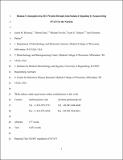Files in this item
Human cytomegalovirus IE1 protein disrupts interleukin-6 signaling by sequestering STAT3 in the nucleus
Item metadata
| dc.contributor.author | Reitsma, Justin M | |
| dc.contributor.author | Sato, Hiromi | |
| dc.contributor.author | Nevels, Michael | |
| dc.contributor.author | Terhune, Scott S | |
| dc.contributor.author | Paulus, Christina | |
| dc.date.accessioned | 2018-07-03T16:30:37Z | |
| dc.date.available | 2018-07-03T16:30:37Z | |
| dc.date.issued | 2013-10 | |
| dc.identifier.citation | Reitsma , J M , Sato , H , Nevels , M , Terhune , S S & Paulus , C 2013 , ' Human cytomegalovirus IE1 protein disrupts interleukin-6 signaling by sequestering STAT3 in the nucleus ' , Journal of Virology , vol. 87 , no. 19 , pp. 10763-10776 . https://doi.org/10.1128/JVI.01197-13 | en |
| dc.identifier.issn | 0022-538X | |
| dc.identifier.other | PURE: 173809915 | |
| dc.identifier.other | PURE UUID: 48e8bb96-5d65-4aa3-803b-12f7589109ef | |
| dc.identifier.other | PubMed: 23903834 | |
| dc.identifier.other | Scopus: 84886016486 | |
| dc.identifier.other | ORCID: /0000-0002-7115-407X/work/28624009 | |
| dc.identifier.other | ORCID: /0000-0002-4123-5629/work/47136635 | |
| dc.identifier.uri | https://hdl.handle.net/10023/14872 | |
| dc.description.abstract | In the canonical STAT3 signaling pathway, binding of agonist to receptors activates Janus kinases that phosphorylate cytoplasmic STAT3 at tyrosine 705 (Y705). Phosphorylated STAT3 dimers accumulate in the nucleus and drive the expression of genes involved in inflammation, angiogenesis, invasion, and proliferation. Here, we demonstrate that human cytomegalovirus (HCMV) infection rapidly promotes nuclear localization of STAT3 in the absence of robust phosphorylation at Y705. Furthermore, infection disrupts interleukin-6 (IL-6)-induced phosphorylation of STAT3 and expression of a subset of IL-6-induced STAT3-regulated genes, including SOCS3. We show that the HCMV 72-kDa immediate-early 1 (IE1) protein associates with STAT3 and is necessary to localize STAT3 to the nucleus during infection. Furthermore, expression of IE1 is sufficient to disrupt IL-6-induced phosphorylation of STAT3, binding of STAT3 to the SOCS3 promoter, and SOCS3 gene expression. Finally, inhibition of STAT3 nuclear localization or STAT3 expression during infection is linked to diminished HCMV genome replication. Viral gene expression is also disrupted, with the greatest impact seen following viral DNA synthesis. Our study identifies IE1 as a new regulator of STAT3 intracellular localization and IL-6 signaling and points to an unanticipated role of STAT3 in HCMV infection. | |
| dc.format.extent | 14 | |
| dc.language.iso | eng | |
| dc.relation.ispartof | Journal of Virology | en |
| dc.rights | © 2013, American Society for Microbiology. This work has been made available online in accordance with the publisher’s policies. This is the author created accepted version manuscript following peer review and as such may differ slightly from the final published version. The final published version of this work is available at https://doi.org/10.1128/JVI.01197-13 | en |
| dc.subject | Animals | en |
| dc.subject | Astrocytoma | en |
| dc.subject | Blotting, Western | en |
| dc.subject | Cell Nucleus | en |
| dc.subject | Cells, Cultured | en |
| dc.subject | Cytomegalovirus | en |
| dc.subject | Cytomegalovirus Infections | en |
| dc.subject | Fibroblasts | en |
| dc.subject | Fluorescent Antibody Technique | en |
| dc.subject | Humans | en |
| dc.subject | Immediate-Early Proteins | en |
| dc.subject | Interleukin-6 | en |
| dc.subject | Mice | en |
| dc.subject | Phosphorylation | en |
| dc.subject | RNA, Messenger | en |
| dc.subject | Real-Time Polymerase Chain Reaction | en |
| dc.subject | Reverse Transcriptase Polymerase Chain Reaction | en |
| dc.subject | STAT3 Transcription Factor | en |
| dc.subject | Signal Transduction | en |
| dc.subject | Trans-Activators | en |
| dc.subject | Virus Replication | en |
| dc.subject | QH301 Biology | en |
| dc.subject | QR355 Virology | en |
| dc.subject.lcc | QH301 | en |
| dc.subject.lcc | QR355 | en |
| dc.title | Human cytomegalovirus IE1 protein disrupts interleukin-6 signaling by sequestering STAT3 in the nucleus | en |
| dc.type | Journal article | en |
| dc.description.version | Postprint | en |
| dc.contributor.institution | University of St Andrews. School of Biology | en |
| dc.contributor.institution | University of St Andrews. Biomedical Sciences Research Complex | en |
| dc.identifier.doi | https://doi.org/10.1128/JVI.01197-13 | |
| dc.description.status | Peer reviewed | en |
This item appears in the following Collection(s)
Items in the St Andrews Research Repository are protected by copyright, with all rights reserved, unless otherwise indicated.

